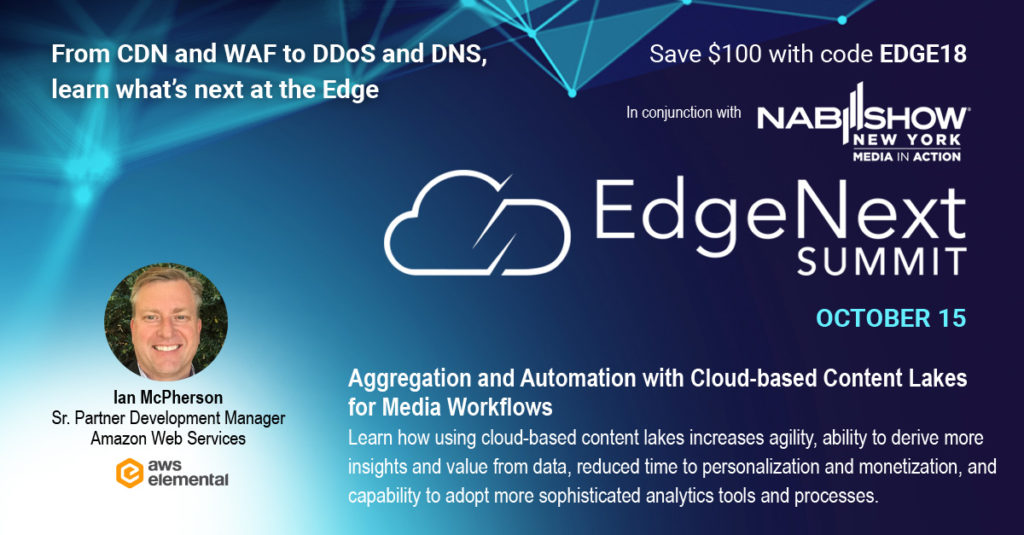 At my recent EdgeNext Summit, there was a lot of discussion about how edge computing can be used to deliver next generation OTT viewing experiences with low latency. Traditional HTTP streaming formats such as HLS and MPEG-DASH have gained wide acceptance, making it relatively easy to reach viewers on almost any viewing device at global scale. However, these formats have significant limitations when used in traditional live streaming workflows, including slow startup, stream latencies, and latency drift over time. By utilizing edge compute resources, new methods and formats are emerging to address these limitations and improve the experience for viewers and content distributors.
At my recent EdgeNext Summit, there was a lot of discussion about how edge computing can be used to deliver next generation OTT viewing experiences with low latency. Traditional HTTP streaming formats such as HLS and MPEG-DASH have gained wide acceptance, making it relatively easy to reach viewers on almost any viewing device at global scale. However, these formats have significant limitations when used in traditional live streaming workflows, including slow startup, stream latencies, and latency drift over time. By utilizing edge compute resources, new methods and formats are emerging to address these limitations and improve the experience for viewers and content distributors.
Live streaming has some inherent challenges that impact infrastructure requirements differently from traditional VOD delivery. Demand for live events can grow quite quickly, requiring instant scalability. For example, the recent online trivia craze has seen demand for online streams grow from zero to over one million viewers in just a matter of minutes, creating massive challenges in ramping to meet this instant demand. Unlike traditional on-demand workflows where popular content can be pre-cached in multiple locations to reduce bottlenecks, live content must be ingested, packaged, and pushed to edge locations as it is created. And with growing viewer frustration around poor user experiences when it comes to streaming live events, caching and buffering of live content to gain scalability and ensure reliable playback becomes a greater challenge.
Traditional cloud service providers offer hyper-scale data centers with computing resources, but they are in relatively few locations and often not located in densely populated areas where viewers may reside. Sending source video streams from these centralized cloud data centers to viewers in distant locations requires extensive middle-mile capacity and can create peering bottlenecks as viewership grows. To viewers, this often means slow or inconsistent startup of video streams, video quality degradation as more viewers watch the event, or even the inability to join popular live streams. These quality, reliability and scalability challenges are impeding the way consumers think of live streaming as a true replacement to cable TV.
Edge computing can help alleviate these bottlenecks by sending source streams to edge servers that perform stream splitting and replication functions. By locating these edge servers in more locations across the globe, edge computing provides the ability to scale up to meet the demands of even the largest live events. By scaling at the edge, traditional bottlenecks are avoided and transit costs are reduced by serving streams from locations that are closer to viewers. And by distributing this capacity in metropolitan areas where viewers are located, it ensures lower latency and higher QoE by reducing the distance the packaged stream must travel to the viewer, reducing transit costs and helping to eliminate peering bottlenecks. The result is greater scalability to provide higher-quality viewing experiences.
One of the live streaming technologies that many think is ideally suited for edge computing is WebRTC. Source video feeds can be ingested through local ingest locations using traditional low-latency streaming formats such as RTMP. The source video can then be pushed to edge servers around the globe where the RTMP feed is converted to WebRTC through edge compute instances running in locations close to viewers. Unlike traditional HTTP live streaming formats, WebRTC uses UDP instead of TCP. UDP streaming takes advantage of modern fiber-based IP infrastructures that utilize hardware-based switches and routers to deliver higher sustained average bandwidth and picture quality to viewers.
WebRTC also promises to open up new interactive workflows by allowing viewers to simultaneously watch live streams at the same time. With the growing popularity of live online gaming such as Fortnite and the legalization of sports betting in the U.S., the ability for content distributors to deliver synchronized interactive online live streaming will help drive the increased consumption of live content and the need for better edge computing functionality and scale.
One of the first CDN companies that has implemented this approach to using edge compute for scalable live video streaming is Limelight Networks. And with their recently announced partnership with Ericsson to leverage its UDN Edge Cloud Platform to provide edge computing and delivery within carrier networks should provide even greater scalability and capacity for live video streaming at the edge. This will become increasingly important as 5G begins to be rolled out, as I noted in my recent blog Here’s Why Today’s Video Infrastructure Is Not Ready For 5G, And How Edge Technologies Can Help.
All CDN vendors are talking about ultra-low latency video delivery, but not a single one will tell you it’s easy to do at scale. It takes a lot of resources to deploy and adds overhead cost to operating their service. Aside from the technical challenges in scaling, CDNs also have to target specific customers who see the value and are willing to pay more for the improved user experience. In a recent survey I did of over 100 broadcast and media customers, 80% of them said they wanted ultra-low latency functionality, but were not willing to pay more for it. Many expect the functionality to be part of a standard CDN delivery service.
By utilizing edge computing capacity within carrier networks as well as in globally distributed data centers to scale and distribute live video streams, content distributors want to reduce costs while ensuring the highest quality live viewing experiences on both mobile and fixed devices. Edge infrastructure will help make this a reality, and it’s going to take time for the business model to be figured out, but it will happen. I’m excited to see what new applications will be enabled in the live video world from the edge and with low-latency. They are coming.

 At my recent
At my recent  Season 7 of Epic Games Fortnite kicked off today on PS4, Xbox One, PC and the Nintendo Switch and multiple ISPs I have spoken to have said it’s made up some of the largest percentage of traffic they have ever seen on their network. A few ISPs reported Fortnite accounted for more than 50% of their inbound internet traffic (peering/transit/CDN/caching) at peak today, with one telling me it was as high as 62% of their traffic.
Season 7 of Epic Games Fortnite kicked off today on PS4, Xbox One, PC and the Nintendo Switch and multiple ISPs I have spoken to have said it’s made up some of the largest percentage of traffic they have ever seen on their network. A few ISPs reported Fortnite accounted for more than 50% of their inbound internet traffic (peering/transit/CDN/caching) at peak today, with one telling me it was as high as 62% of their traffic.


